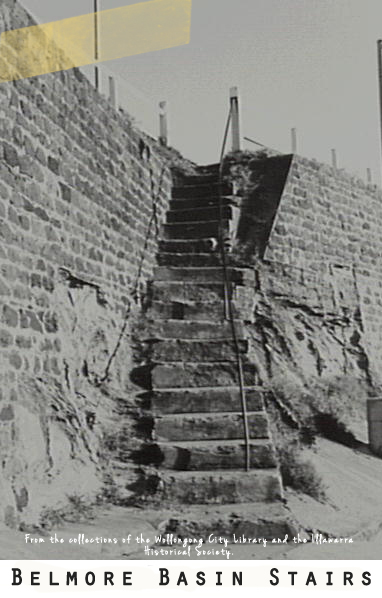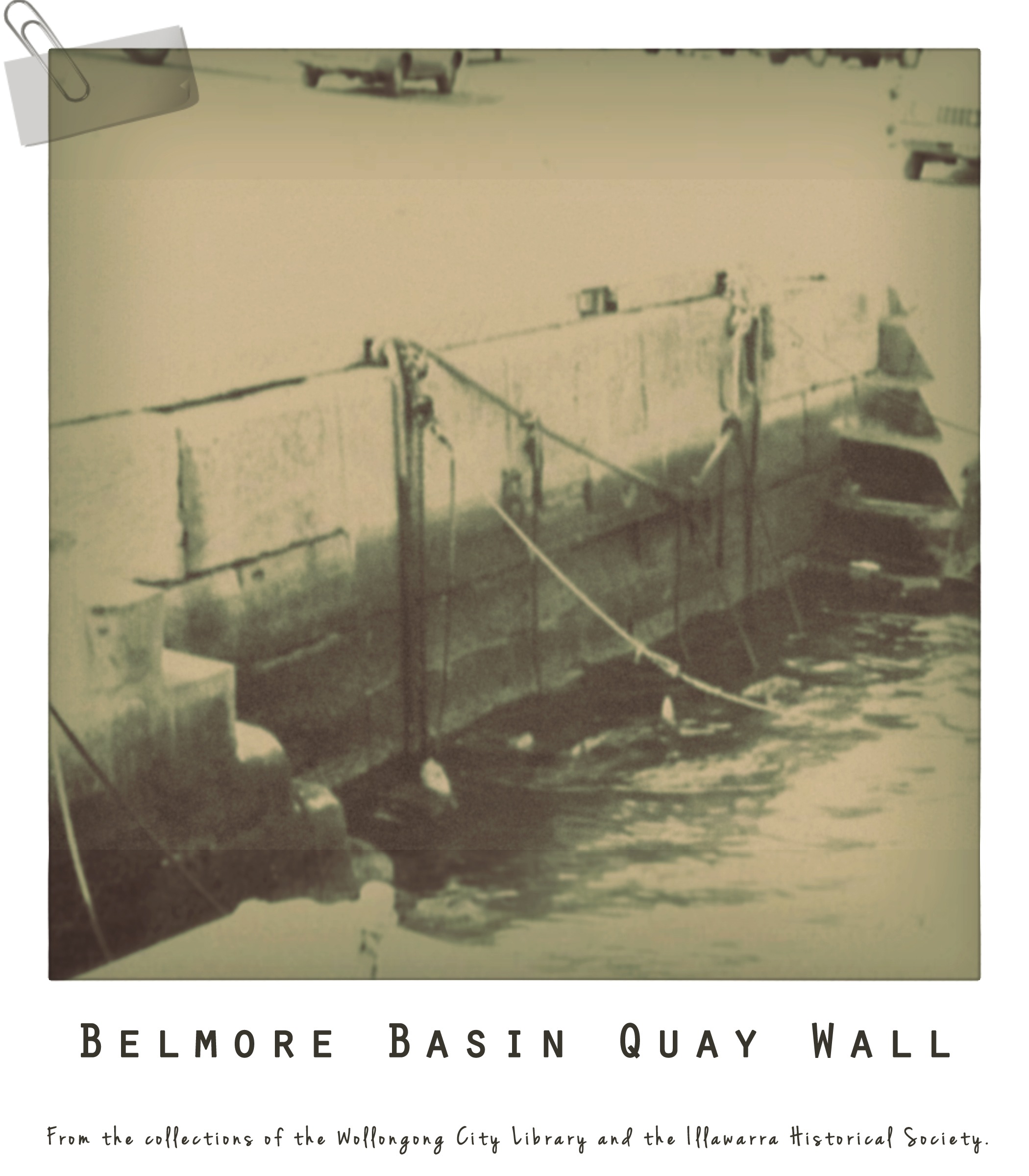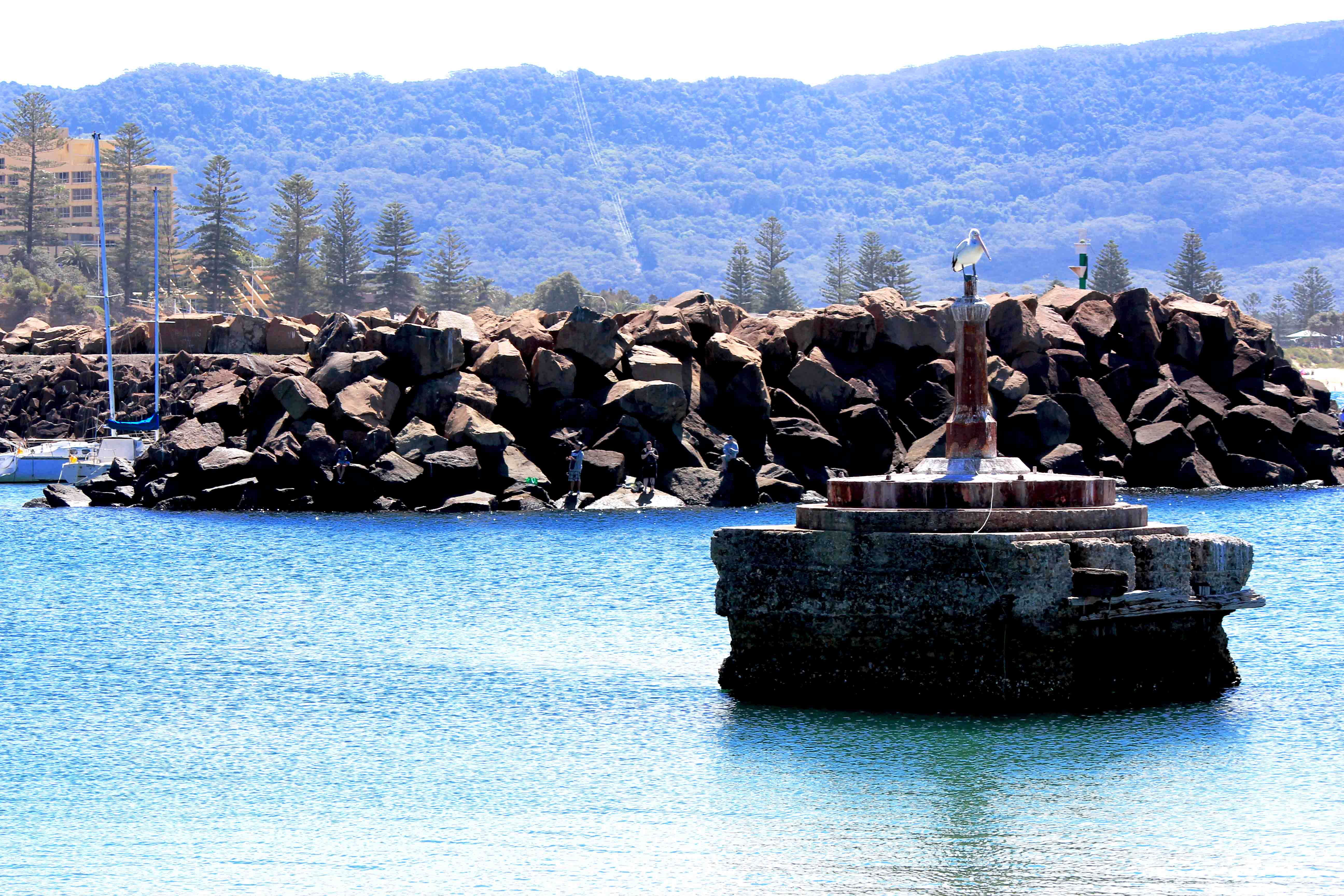
Early Construction
In February 1837, Captain George Barney was instructed to carry out harbour works at Wollongong. The project involved the construction of the first Wollongong Basin with a pier along the northern end and quay wall toward the township and was to cost three thousand five hundred pounds. The work began on the 18th of December 1837, with an estimated 300 convicts, under the guard of Captain Plunkett and Mr Cronin as the chief stone mason. Work progressed well and Mr Cronin laid the first stone on the 23rd May, 1839. The bulk of the labour was carried out by convicts.
Initially, the proposal was to build a Basin 100 feet long, 35 feet wide and 14 feet deep with a stone pier on the northern  side. After construction commenced, it was decided to substantially increase the dimensions of the basin to 300 feet long by 150 feet wide, with water 14 feet deep at high tide and 8 feet at low tide. The Basin, which was also referred to as the ‘Government Dam’, was excavated through what was described at the time as 'intensely hard rock', while a coffer dam and powerful pumps operated continuously to hold back the sea. Cut rock was prepared from the excavated material and used to construct the sea walls including the Quay wall at the eastern end of Brighton Beach and the Pier and Pier Head, that formed the northern side or breakwater of this first basin. Mooring chains were in position across the bay at Brighton Beach to provide anchorage during the construction of the Basin in 1839.
side. After construction commenced, it was decided to substantially increase the dimensions of the basin to 300 feet long by 150 feet wide, with water 14 feet deep at high tide and 8 feet at low tide. The Basin, which was also referred to as the ‘Government Dam’, was excavated through what was described at the time as 'intensely hard rock', while a coffer dam and powerful pumps operated continuously to hold back the sea. Cut rock was prepared from the excavated material and used to construct the sea walls including the Quay wall at the eastern end of Brighton Beach and the Pier and Pier Head, that formed the northern side or breakwater of this first basin. Mooring chains were in position across the bay at Brighton Beach to provide anchorage during the construction of the Basin in 1839.
The first phase of harbour construction was completed by 25 November, 1844. Within a decade, the passenger and freight trade had increased to the extent where a second pier or jetty was needed. So a timber jetty was built out from the southern side of the Basin, in the vicinity of the current public jetty. However, the earlier incomplete removal of the coffer dams in 1844 meant the entrance depth was only 5 feet 6 inches and the continued presence of mooring chains across the mouth meant that anchorage was unsafe. Use of the harbour was increasing as the district’s roads remained poor and production in the district was increasing.
Steamers
In 1838, ‘Old Billy’ the steamer officially named ‘William the Fourth’ from the Parramatta River, was calling in weekly, and the Illawarra Steam Packet Company was formed. Their steamer, ‘Maitland’ travelled to Sydney twice per week. In 1839, ‘Sophia Jane’, regularly anchored offshore, and supplies were brought into Brighton Beach on a barge and transported from the beach along a purpose built tramway to the Waterloo Stores, which later became the Brighton Stores.

Belmore Basin
The substantially completed Basin was officially flooded and opened on Tuesday 6th October 1868 and is cited as one of the greatest events in the history of Wollongong. The Basin was named after the Governor Earl Belmore, by Lady Belmore who stood on the wharf and broke a bottle of champagne on the bow of the government ship, “Thetis”. A luncheon followed at the Brighton Hotel with Mr Charles Throsby-Smith, Mayor of Wollongong.
Tee-Jetty
A timber Tee-Jetty was built in 1880 to increase the harbour’s cargo handling capacity. It was designed by E.O. Moriarty, the engineer who designed Belmore Basin, the Breakwater Lighthouse and its’ Eastern Breakwater. The harbour railway lines were extended onto the Tee-Jetty and there was a steam crane with a vertical boiler mounted at the outer wharf edge that was used for the loading and unloading of cargo.
The Tee Jetty was constructed at a time when, in hindsight, the demand on Wollongong Harbour was about to fall, due to the increased investment in the development of the deep sea harbour at Port Kembla. As a result, the Tee-Jetty was not maintained and was allowed to fall into disrepair. It was demolished in 1926. All that remains of the Tee-Jetty is the support column and concrete foundation for the steam crane, surrounded by water. Also associated with the operation of the Tee-Jetty is the sandstone block Sea Wall, which was constructed in 1881. The wall is up to 12 feet high and was built to prevent waves from washing into the basin during heavy seas and to protect the coal wagons crossing to the Tee-Jetty. A rubble embankment 4 feet high above the rock platform once connected the south eastern end of the wall with Pulpit Rock.
Progress
The deeper water and infrastructure at Port Kembla could accommodate larger ships than Belmore Basin and as both Port Kembla and the Illawarra railway developed, the facilities at Wollongong began to lose their competitive edge and so the estimated 537,000 pounds required to develop the Wollongong Harbour Trust schemes, was not forthcoming. Some work was commenced for the major scheme, including a section of breakwater connecting Pulpit Rock with Flagstaff Hill. This wall survives. Also, in 1893, there was a modest attempt to expand the area of the harbour with the construction of a Northern Breakwater that extends northwards from the Breakwater Lighthouse. This plan was abandoned when the Breakwater was about 80 metres in length. The Trust was dissolved in 1895 at the request of the Commissioners and the control of the Harbour reverted to the Government. In the same year, the Illawarra Steamship and Navigation Company announced their intention to cease conveying passengers and to carry freight only.
On 23/12/1898, the Port Kembla Harbour Act became law and shipments of 4,000 tons in one ship had been made at Port Kembla, compared to a maximum 800 tons per ship from Wollongong. Within two years, Wollongong Harbour no longer traded regularly with other ports, except Sydney. Mt Keira and Mt Pleasant continued to operate their train lines with coal for the domestic Sydney market but this activity rapidly declined from 169,215 tons in 1922 to 22,945 tons in 1928 and ceased in 1936.
More demolitions and a number of constructions took place within the harbour area in response to the shift of focus from coal toward the fishing industry, leisure and tourism.
By 1927 the Commercial Fishing Fleet had built up to 14 motorised fishing boats. The first Fishermen’s Co-operative building was constructed in the vicinity of the former ISCSNCo Ltd. building prior to 1937. The Co-op Building was a single storey, weatherboard structure oriented northwards, with a boat unloading deck and double door overlooking the southern wall of the Basin. Harley’s Sea Food later built a small retail fish outlet adjacent to the Co-op, to the west along the quay wall.
Currently the boats are predominantly family owned and some are now operated by the third generation of fishermen in the Wollongong Harbour fleet. The fishermen are mainly of Italian descent and retain some of their ancestral cultural festivities such as the annual Blessing of the Fleet, which is to protect the fishermen, their boats and catch throughout the year.
The Fishermen’s Co-operative occupies the Inner Harbour which is Crown Land under Port Reserve R180069 managed by the Minor Ports Unit. The Co-op sub-lets moorings for approximately 30 ocean going fishing boats. Due to the limited space and the ever increasing size of vessels, boats raft together and the fishermen ‘boat hop’ to the edge of the Basin.


